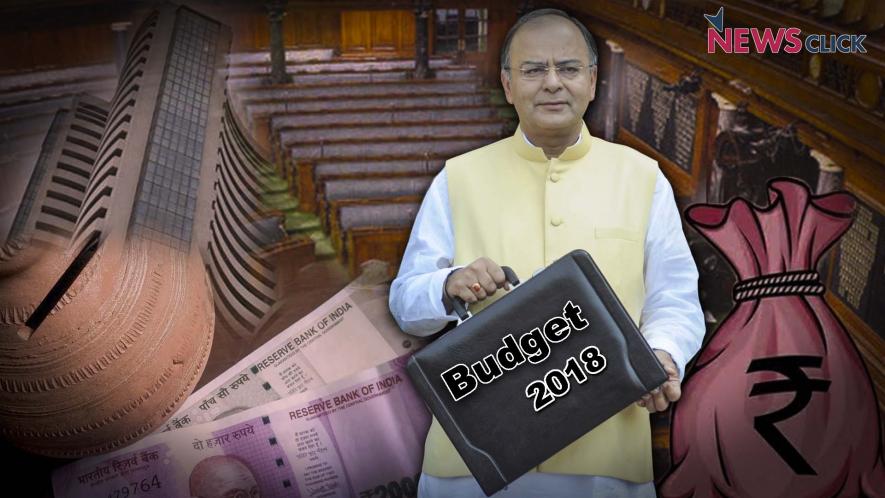Union Budget 2018-19: Con Job for Health, Cutbacks for Education, Contractionary Thrust for Economy

Newsclick Image by Sumit Kumar
The Union Budget 2018-19, coming as it does at a time when the Indian economy is plagued by a growth slowdown and alarmingly low employment generation, has put forward proposals that would be thoroughly inadequate to stimulate demand in the Indian economy.
Furthermore, the allocation for several vital sectors have suffered cuts in real terms.
The total expenditure that the government has budgeted for the 2018-19 financial year is Rs. 24,42,213 crore. This would amount to 13.04 per cent of the projected Gross Domestic Product for 2018-19 (Rs. 1,87,22,302 crore) – which is marginally less than the previous year’s figures of 13.21 per cent of the GDP.
In fact, the government’s capital expenditure would come down even in absolute terms, compared to the previous year’s budget estimates – the figure was Rs. 3,09,801 in 2017-18, which has come down to Rs. 3,00,441.
Instead of raising its spending to provide a fillip to the economy, the government has chosen to continue on the path of contractionary fiscal conservatism.
While this may appear strange considering the fact that investment rates in India have come down in the recent years, it is in keeping with the view expressed by government spokespersons who have pinned their hopes on private investment to generate growth and jobs.
Successive governments in India have been trying to bring about “fiscal consolidation” by curtailing government expenditure while shying away from mobilising revenues by making the elite pay. This year too, the government is aiming to reduce the fiscal deficit from the previous year’s level of 3.5 per cent to 3.3 per cent in 2018-19, even as capital expenditure is cut.
The funds allocated to the Ministry of Rural Development has come down from 0.66 per cent to 0.61 per cent of the GDP. Allocation for the Mahatma Gandhi Rural Employment Guarantee Programme has remained stagnant at Rs. 55,000 crore.
Sectors such as education and health have once again fallen victim to the morbid opposition to government spending that has been characteristic of neoliberal regimes such as those led by the BJP and the Congress.
Allocation for health lower in proportion to GDP
While the government has announced a new health insurance programme – the National Health Protection Scheme – with the claim that it would cover 10 crore poor and vulnerable families, no funds have been allocated for it. This has attracted suspicion that the new scheme is a mere repackaging of already existing programmes.
Insurance schemes are no substitutes for a universal, public health system. India’s experience with state-funded insurance schemes show that such schemes end up facilitating the transfer of public money to the coffers of private insurance companies and private hospitals, thereby boosting their profits, while the people struggle to get benefits.
Keeping the mystery of the scheme’s funding aside, the actual allocation for health in the coming year is Rs. 54,600 crore. This would amount to 0.29 per cent of the GDP, down from 0.32 per cent of the GDP during the previous year. Allocation for the National Rural Health Mission has been cut from Rs. 25,458.61 crore to Rs. 24,279.61 crore, with the total outlay for the National Health Mission being reduced from Rs. 30,801.56 crore to Rs. 30,129.61 crore.
Fund cuts for education
The BJP government has reserved perhaps the most hideous gifts for the students of the country.
Funding for education has come down from 0.49 per cent of the GDP in 2017-18 to 0.45 per cent of the GDP in the coming year. Central government spending on school education as a proportion of GDP has been cut from 0.28 per cent to 0.27 per cent. Higher education has suffered similar fund cuts, from 0.21 per cent of the GDP to 0.19 per cent.
Fund allocation for the Kendriya Vidyalayas, at Rs. 4,425 crore, would be less than the previous year’s revised estimates of Rs. 4,600.53 crore. Funding for the Navodaya Vidyalayas also have been cut similarly from Rs. 3,025 crore to Rs. 2,793 crore.
In spite of the tall talk on Digital India by the Prime Minister and others in the government, the funding for Digital India e-learning has been cut from Rs. 518 crore to Rs. 456 crore.
Allocation for the University Grants Commission has been cut, from previous year’s revised estimates of Rs. 4,922.74 crore to Rs. 4,722.75 crore in 2018-19.
The Indian Institutes of Technology (IITs) have seen their fund allocation cut steeply, from Rs. 8244.80 crore in 2017-18 to Rs. 6326 crore, while the National Institutes of Technology (NITs) have suffered an erosion in funds from Rs. 3668.17 crore to Rs. 3203.40 crore.
As we have pointed out earlier, government spending accounts for a significantly higher proportion of the GDP in countries where the vast majority of people enjoy a decent standard of living. But India has been refusing to tax its rich in order to mobilise resources so as to raise government spending to match up to the challenges faced by the country.
At the same time, tax concessions for the corporates amounted to a whopping Rs. 86,144.82 crore in 2016-17, which was higher than the Rs. 83,492.03 crore projected for the year in the previous budget. According to Union Budget 2018-19, the projected estimate of tax concessions to the corporates for 2017-18 is Rs. 85,062.11 crore. In other words, the BJP, which is the biggest beneficiary of corporate donations to political parties, has not forgotten its masters!
Get the latest reports & analysis with people's perspective on Protests, movements & deep analytical videos, discussions of the current affairs in your Telegram app. Subscribe to NewsClick's Telegram channel & get Real-Time updates on stories, as they get published on our website.






















